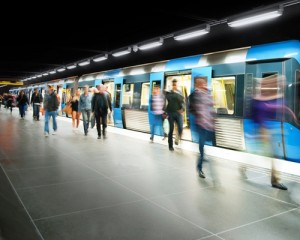5 critical attributes subway video surveillance systems need (part 2)
May 12, 2015
 In the first part of this series, we provided an overview of the common oversight challenges subway system operators face, and why real-time monitoring and a robust network are so critical for their video surveillance solutions. But, these are far from the only key traits metro rail oversight teams need from their video surveillance solutions. In particular, here are three more critical attributes to consider:
In the first part of this series, we provided an overview of the common oversight challenges subway system operators face, and why real-time monitoring and a robust network are so critical for their video surveillance solutions. But, these are far from the only key traits metro rail oversight teams need from their video surveillance solutions. In particular, here are three more critical attributes to consider:
3) Wireless links
More often than not, major public transportation systems cover a lot of ground. For example, the Metro in and around the District of Columbia is a little over 10 miles long and the Tube in London stretches out over around 250 miles, according to Business Insider.
While it is certainly possible to have a wired network form the backbone of a video surveillance system, that is more often than not a prohibitively expensive proposition for metro rail operators. From 2001 to 2013, costs related to installing new fiber optic cabling ranged from around $6,800 to up to around $79,000 per mile, according to numbers from the U.S. Department of Transportation. This would mean that the Massachusetts Bay Transit Authority for example, if it wanted to established a brand new network across all 64 miles of the T subway and light rail network in and around Boston, would have to spend anywhere from $435,000 to $5.05 million on just cabling. This is just on the low end too, as the train network in Boston is much shorter than cities like Madrid and Hong Kong. For public agencies that are often cash strapped, these kinds of expenses are typically too high to stomach.
Instead of relying on often expensive wires for video surveillance, metro rail operators get far more bang for their buck with a wireless solution. For a fraction of the price of fiber, a wireless mesh network can provide a reliable back-end infrastructure capable of supporting high-bandwidth data transfers 24/7.
4) Ability to clearly monitor fast-moving vehicles
Typically, a subway train is not moving all that fast, especially on a line that has frequent stops that are close together. But, in some systems, trains will sometimes move at very high speeds. For instance, vehicles in the Seoul subway systems will occasionally reach up to 50 miles per hour. A video network must be able to keep up with fast-moving trains, to make sure that nothing is ever out of view and that images never appear blurry.
5) Capable of supporting high bandwidth data transfer
One minute of streaming HD video is about 15 MB, according to AT&T. Multiply that over many hours and dozens of video cameras, and it becomes readily apparent just how bandwidth is needed to support a robust video surveillance network. By opting for a provider that offers purpose-built networking solutions specifically with video and surveillance in mind, metro rail operators can be sure they are getting a solution built to support high-bandwidth applications like video streaming over the long term.
These are just five of the many variables subway system operators must keep in mind when selecting a video surveillance system. By working with Firetide, these operators can be sure they are getting and robust and reliable wireless mesh networking system capable of handling all of the unique challenges presented by public transportation infrastructure. The Seoul Metropolitan Rapid Transit Corporation turned to Firetide for help with their video oversight network in 2010, and has seen major benefits as a result of the partnership.
“Firetide was selected because no other vendor’s wireless mesh equipment could provide the high speed performance required to deliver streaming video from the station to moving rail cars and operate in one of harshest of environments for RF networks,” said Jung Yeong-Hyun, project manager of Global Telecom. “We were also tremendously impressed with Firetide’s sophisticated regional support organization that understood the difficulties posed by the subway system.”
To learn more about available options, contact Firetide today.

